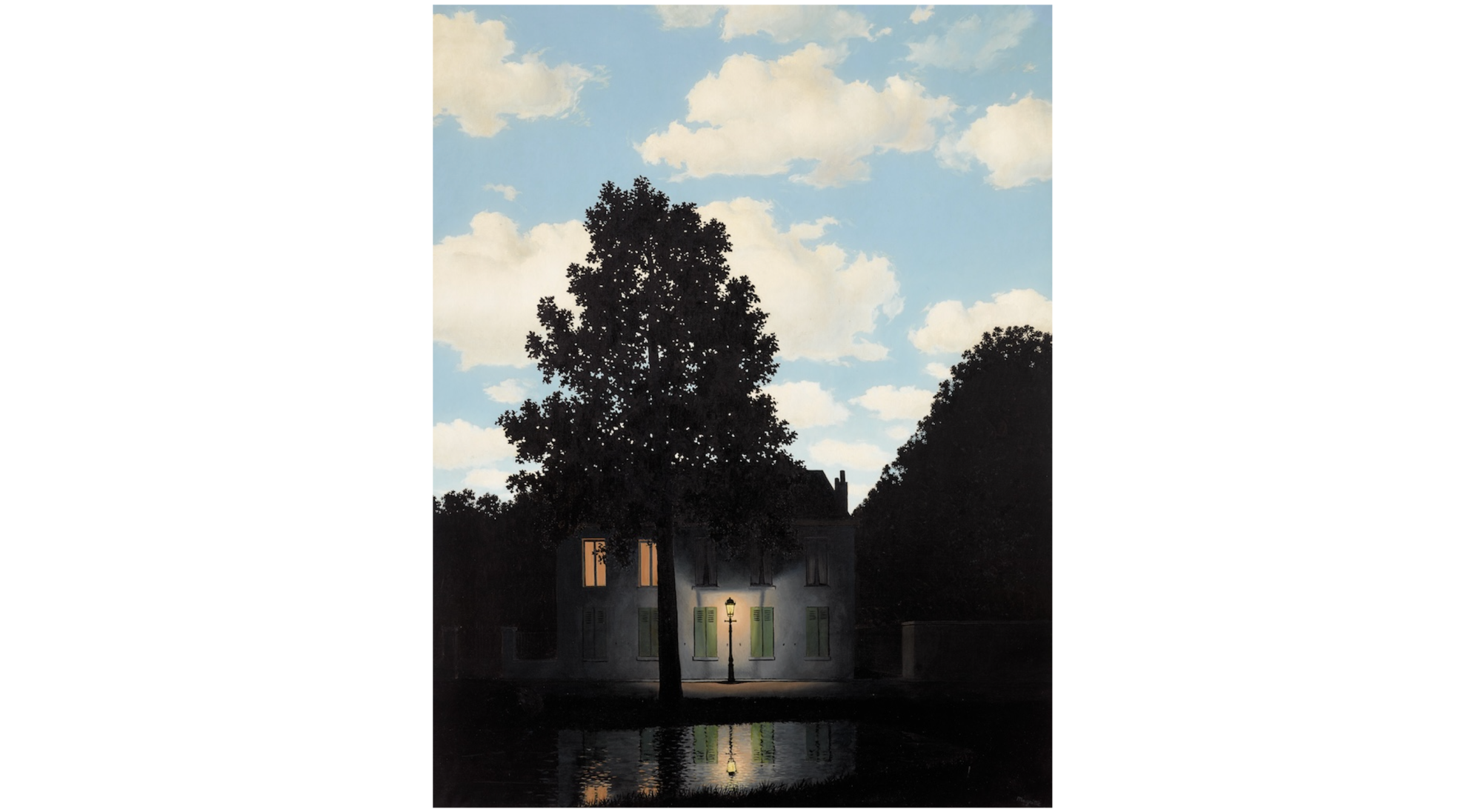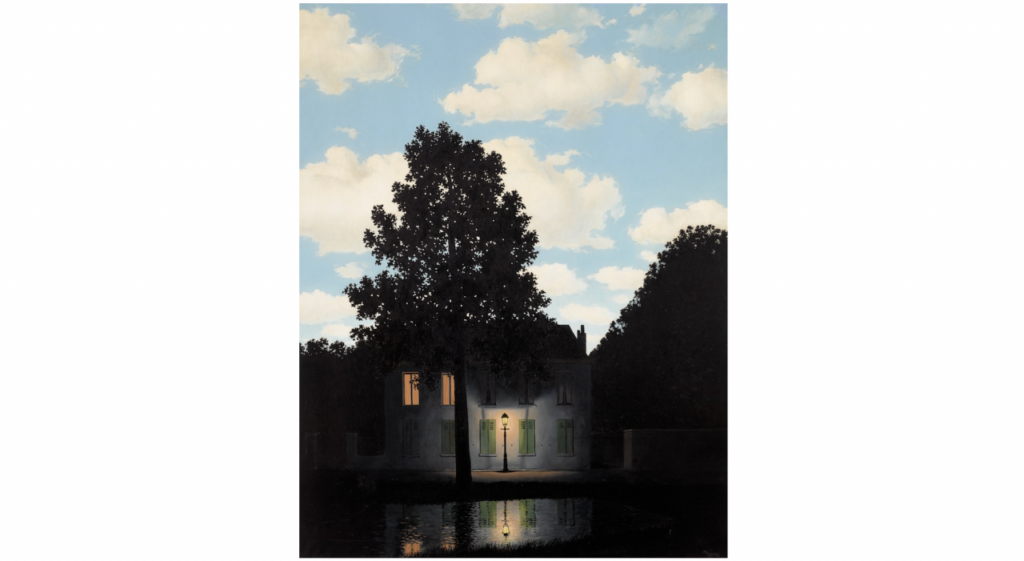
On Tuesday night during Christie’s 20th century evening sale, after eleven or so tense minutes of hushed phone conversations behind cupped hands and quick currency conversions, Rene Magritte’s paintng L’empire des lumières (1954) sold for $121 million.
At a press conference after the sale Alex Rotter, Christie’s chairman of 20th and 21st century art, said the house this season had been operating on the “masterpiece approach,” which seems to have been do whatever it takes to secure the best one or two paintings available. That gambit worked. The Magritte, plus a stellar Rucha, the 1964 Standard Station, Ten-Cent Western Being Torn in Half, which sold for $68 million, more than made up for any mediocre results.
Magritte, who for the last few years has surfing on the crest of the newly invigorated Surrealism market, is now among the artists whose work have sold for over $100 million at auction. Here are a few of the artists who share the view from the art market’s multi-million dollar peak.
-
Salvator Mundi, Leonardo da Vinci

Image Credit: Getty Images Without question da Vinci’s Salvator Mundi (c. 1500) is the heavyweight champ when it comes to auction prices. Back in 2017 the picture caused a frenzy in the art world, and the world at large, when it sold at Christie’s New York for an eye-watering $450 million. Even the guarantee, at $100 million, would have earned the work a spot among the most expensive works of all time. Christie’s masterstroke here was a promotional video during which people stood in front of the work, Leonardo DiCaprio and Patti Smith among them, with some even letting loose a tear at its depth and beauty. But what exactly were they looking at?
The work is clouded in controversy, with critics arguing that it underwent so much restoration after it was discovered (and bought for less than $10,000) that it may as well been credited to its pre-sale conservator, Dianne Modestini. The picture is also a central character in the Bouvier affair, having been one of the works the Swiss businessman and former Free Port magnate Yves Bouvier sold to Russian collector Dmitry E. Rybolovlev. Bouvier bought the work for $80 million and flipped it to Rybolovlev for $127.5, in a decades-long price gouging operation that sparked a legal battle between the two men, in multiple districts and countries, and that still goes on today.
According to rumors the buyer was Saudi Crown Prince Mohammed bin Salman, who is reportedly planning to build a gallery for the work.
-
Interchange by Willem de Kooning and Number 17A by Jackson Pollock

Image Credit: Getty Images for Pérez Art Museu In September of 2015 the billionaire Ken Griffin, founder of hedge fund firm Citadel, paid $500 million dollars for two ab-ex masterpieces, Jackson Pollock’s erratic and deeply colored drip painting 17A (1948) and Willem de Koonig’s 1955abstraction known as Interchange. While the sale was private, by the following year it was widely reported that Griffin had bought the two works from music tycoon David Geffen’s foundation. Both works constituted a record price for their respective artists and went on view the same month of the sale at the Art Institute of Chicago, where Griffin been a trustee since 2004. According to reports at the time Griffin paid $300 for the de Kooning and $200 million for the Pollock.
-
The Card Players, Paul Cézanne

Image Credit: Photo : Copyright © Musée d’Orsay, Dist. RMN-Grand Palais / Patrice Schmidt. Qatar, the oil-rich nation with ever-growing cultural ambitions, purchased Paul Cézanne’s The Card Players (1892–93) in 2011 for over $250 million, setting a record for the highest price ever paid for a work of art at the time. The moody, stoic painting is a landmark of post-Impressionist art. The acquisition solidified Qatar’s bourgeoning place in the art world, as only five works from the series exist, with others housed in major institutions such as the Metropolitan Museum of Art and Musée d’Orsay.
The painting was previously owned by Greek shipping magnate George Embiricos, who rarely lent it out. After his death, his estate facilitated its sale. Art dealers William Acquavella and, reportedly, Larry Gagosian offered upward of $220 million, but the American sharks were easily outbid by Qatar’s royal family.
-
Andy Warhol, Shot Sage Blue Marilyn

Image Credit: Anthony Behar In 2022 Andy Warhol’s Shot Sage Blue Marilyn (1964), a silkscreen portrait of Marilyn Monroe, sold for $195 million at Christie’s New York, setting a record as the most expensive work by a 20th-century artist ever sold at auction. There was competitive bidding among four prospective buyers, but dealer Larry Gagosian eventually won out.
The painting, which for years was in the collection of Swiss art dealers Thomas and Doris Ammann, was sold without a financial guarantee and hammered at $170 million, below its $200 million pre-sale estimate. Still, the Marilyn nearly doubled Warhol’s previous auction record of $105.4 million, achieved in 2013 for his Silver Car Crash (Double Disaster), from 1963.
The “Shot Marilyn” series is considered one of Warhol’s most coveted bodies of work, with only five pieces in existence. At the time, art appraiser David Shapiro told ARTnews that pictures like the Marilyn are often thought of as “trophy art,” fitting into a broader trend of record prices in the private dealer market for blue-chip artists.
-
Paul Gauguin, Nafea Faa Ipoipo (When Will You Marry?)

The Card Player’s coup was the second major acquisition for Qatar’s royal family in three years. In 2014, Paul Gauguin’s 1892 painting Nafea Faa Ipoipo (When Will You Marry?) was sold by Swiss collector and retired Sotheby’s executive Rudolf Staechelin for $210 million to an LLC run by British art dealer Guy Bennett on behalf of the emir of Qatar, Sheikh Tamim bin Hamad al-Thani. The painting, which depicts two Tahitian girls, was part of a family trust collection that had been on loan to the Kunstmuseum Basel for nearly 50 years.
A bit of monetary scandal followed the sale. Auctioneer and adviser Simon de Pury and his wife, Michaela, facilitated the sale, though there was no formal written contract between the de Pury’s and the seller, and weren’t paid a commission, so they sued. Staechelin ultimately had to pay the couple a $10 million commission.

